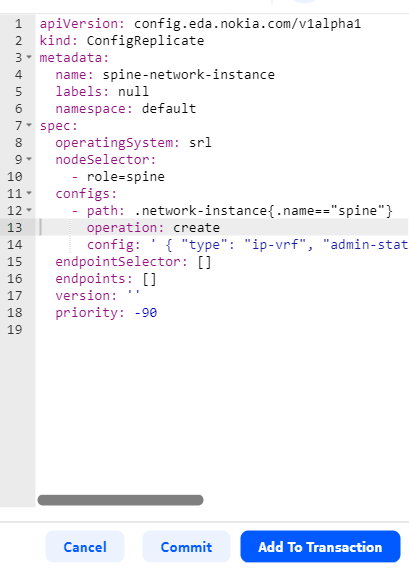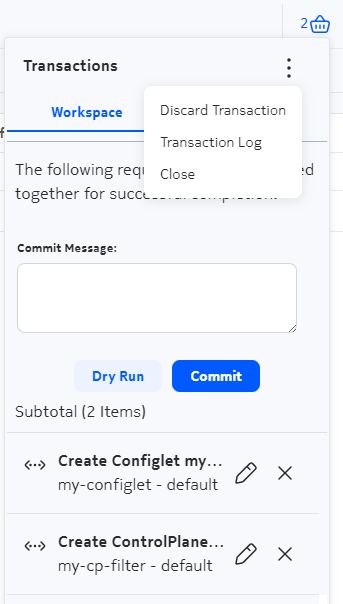Transactions
In EDA, a transaction is a set of changes that must succeed or fail together. If one item in a transaction fails, the whole transaction is deemed to have failed and any successful changes within the transaction are rolled back to their previous state.
Any resource configurations you create, change, or delete in EDA must be committed in order for those changes to be applied to the participating resources.
- Any single configuration change can be committed immediately on its own, in which case it constitutes a transaction consisting of just that change.
- However, you do not need to commit each configurations individually as you create
it. EDA allows you add any new, changed, or removed configuration to a growing set
of configuration changes that you want to commit together as one collective
transaction. When you are ready you can then commit the whole transaction, applying
the entire set of configuration changes together.
The complete transaction, including all of its constituent configuration changes, then succeeds or fails as a unit. If any part of the transaction fails, the whole transaction is rolled back. You can then resolve the blocking issue, and apply the transaction again.
Within EDA, ConfigEngine is the main service behind transactions. Its job is to compute the complete set of resources that must be modified, deleted, or created as part of the transaction; ensure all dependencies and outputs are captured; and then transact the updates, thereby generating changes for NPPs and other controllers.
After a transaction has been successfully processed it is written to EDA's Git repo for persistence, becoming the new accepted state of the infrastructure.
Commit options for a typical resource
When you configure a resource in EDA, you are always presented with the following options to either commit the change, or add it to a transaction:

- Commit: clicking this button immediately commits the change to EDA to be applied to the target device.
- Add to Transaction: clicking this button adds the current resource configuration to the current transaction. It is not committed, or configured on the target device, until the transaction itself is committed.
Transactions drop-down panel
The Basket icon is displayed at the top of every page in the EDA GUI. It indicates when any transactions are pending, and can be used to open the Transaction drop-down.

You can open the Transactions drop-down panel by clicking the Basket icon.
- review the contents of any pending transactions
- perform a dry run of any pending transaction
- add a commit message to a pending transaction
- commit any pending transaction
- discard any pending transaction
- view a list of recently completed transactions
- edit a single configuration
- remove a configuration from the transaction
- restore a removed configuration back into the transaction
You also use this drop-down panel to view the EDA Transaction Log.

Dry runs
In EDA, you can perform a Dry Run of any pending transaction.
In a Dry Run, the system does not send any of the configuration changes to the managed nodes. However, it executes the transaction against EDA's stored information about each participating node, and validates the transaction against that data. This can reveal anticipated configuration issues if the transaction were to proceed normally, and allow you to troubleshoot any errors before committing the transaction on actual nodes.
Commit
Clicking Commit commits the entire transaction. The complete transaction, including all of its constituent configuration changes, then succeed or fail as a unit.
If any part of the transaction fails, the whole transaction is rolled back. You can then resolve the blocking issue, and apply the transaction again.
Recent
Click on the Recent tab to view a list of the most recent transactions. A more complete list of transactions is available from the Transactions log.
Configuration actions
The following actions are available for each configuration within the transaction:
- Edit the configuration: Click the Edit icon to open the original resource configuration page so that you can modify the configuration details.
- Remove the configuration: Click the Minus icon to remove only this configuration from the overall transaction.
- Restore the configuration: after removing a configuration from the transaction, click the Plus icon to restore the configuration as part of the overall transaction.
Additional actions
- Discard Transaction: discards the transaction and all configurations it included. The transaction still appears in the transaction log, but its Success status is False.
- Transaction log: select this action to open the Transactions page, showing a list of recent transactions.
Transactions page
- View the list of transactions
- View a detailed summary of individual transactions
- View the precise configuration changes ("Diffs") in JSON format that were included in any transaction
- revert a successful transaction
- restore a reverted transaction
The Transactions page does not display pending transactions; a transaction must be completed before it appears in this list.
Transactions list
The Transactions list displays all of the transactions recorded in the Transactions log.
The Transactions log does not include the entire EDA transaction history. It is limited to:
- 128 successful transactions
- 1024 failed transactions total (this number is larger than successful transactions because failed transactions are often more important for debugging reasons)
- 25 transactions per user
The following information displayed in the transactions list:
| Column | Description |
|---|---|
| Display ID | An identifier for the transaction, in the form "Transaction <number>". |
| Description | An optional description provided at the time the transaction is committed. |
| Completion Timestamp | The date and time the transaction was completed. |
| Success | Whether the transaction was successful, or failed. |
| State | The state of the completed transaction. |
| Dry Run | Whether a Dry Run has been performed for this transaction. In a Dry Run, the system does not send any of the configuration changes to the managed nodes. However, it executes the transaction against EDA's stored information about each participating node, and validates the transaction against that data. |
| Commit Hash | A unique string that identifies this string in the EDA repository. |
- Summary, which opens the EDA Transaction Summary page showing detailed information for one transaction.
- Revert, which creates a new transaction that effectively undoes the selected transaction. The result is to set the resources affected by the commits in this transaction to their state before the transaction took place.
- Restore, a powerful command that restores all resources to their state at the completion of the selected transaction.
Transactions summary
- The completion status, the name of the transaction, any description provided, and a timestamp for its completion.
- An Error Summary showing the number of
- General errors
- Intent errors
- Node configuration errors
- A Custom Resource (CR) Summary, showing the number of:
- Input CRs (new resource configurations enacted as part of the transaction)
- Changed CRs (existing resources that were reconfigured as part of the transaction)
- Intents Run
- Nodes with Changes
Transaction details
The Errors and CRs that are summarized at the top of the Summary page can be viewed in detail in the Transaction Details panel. Different tabs display lists of input CRs, changed CRs, intents run, nodes with changes, and errors.
Transaction diffs
From the breadcrumb at the top of the Transactions page you select Diffs to view the precise details of the configurations changed as part of this transaction.
Each resource added or changed as part of this transaction is displayed, along with the JSON code representing the new or changed lines in the respective configuration data.
Adding a resource configuration to a transaction
- Create any resource in the EDA GUI.
- Click Add to Transaction at the bottom of the configuration page.
Committing a transaction
-
Click the Basket icon at the top of any page in the EDA
GUI.
Note: When at least one transaction is pending, the basket icon is highlighted and displays a count of the pending transactions available to commit.
-
Optionally, click Dry Run to perform a dry run of this
transaction.
Note: In a Dry Run, the system does not send any of the configuration changes to the managed nodes. However, it executes the transaction against EDA's stored information about each participating node, and validates the transaction against that data.
- Optionally, edit any resource configuration that is part of the current transaction by clicking the Edit icon to the right of the transaction. This opens the original resource configuration page so that you can modify the configuration details.
- Optionally, remove any resource configurations that are currently part of the transaction that you do not want to commit at this time. Remove a transaction by clicking the Minus icon to the right of the transaction.
- Click Commit.